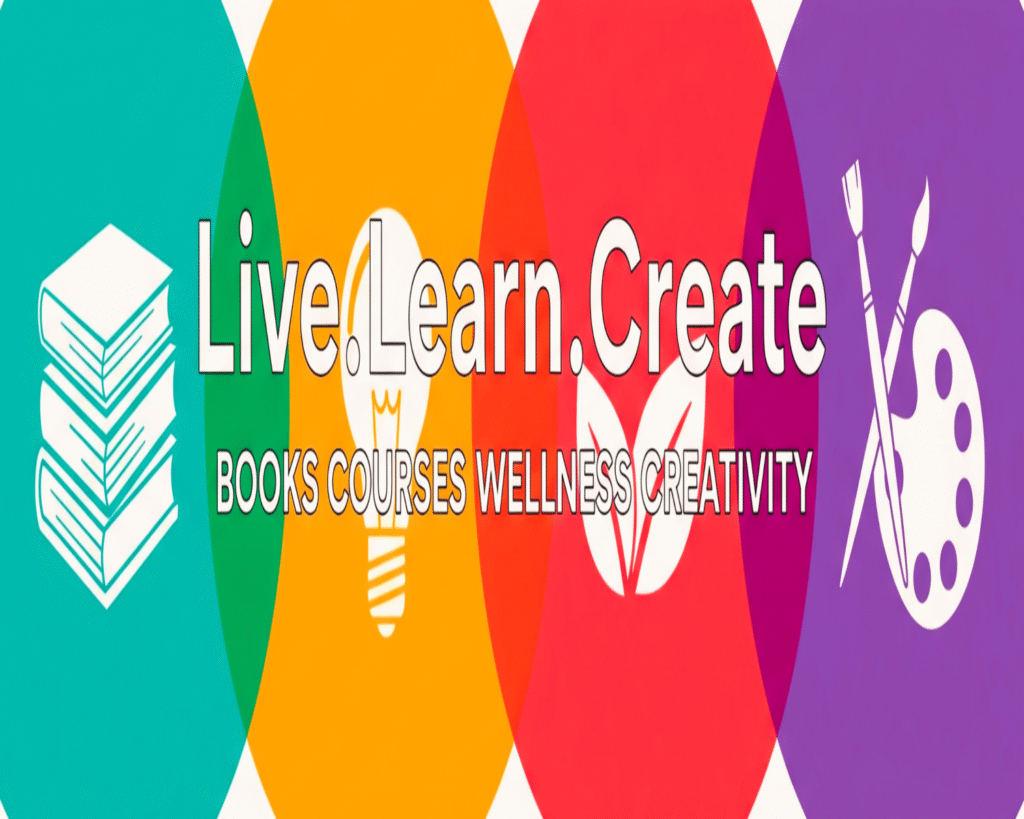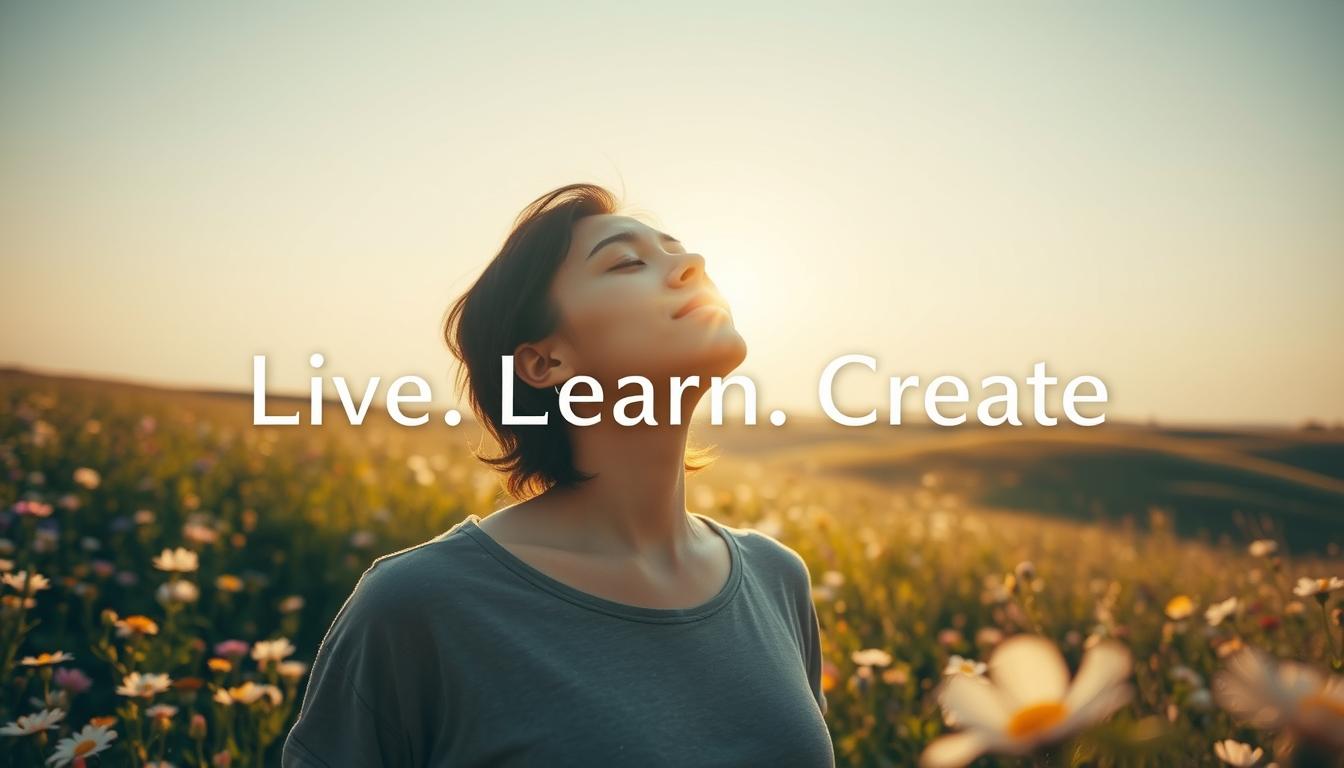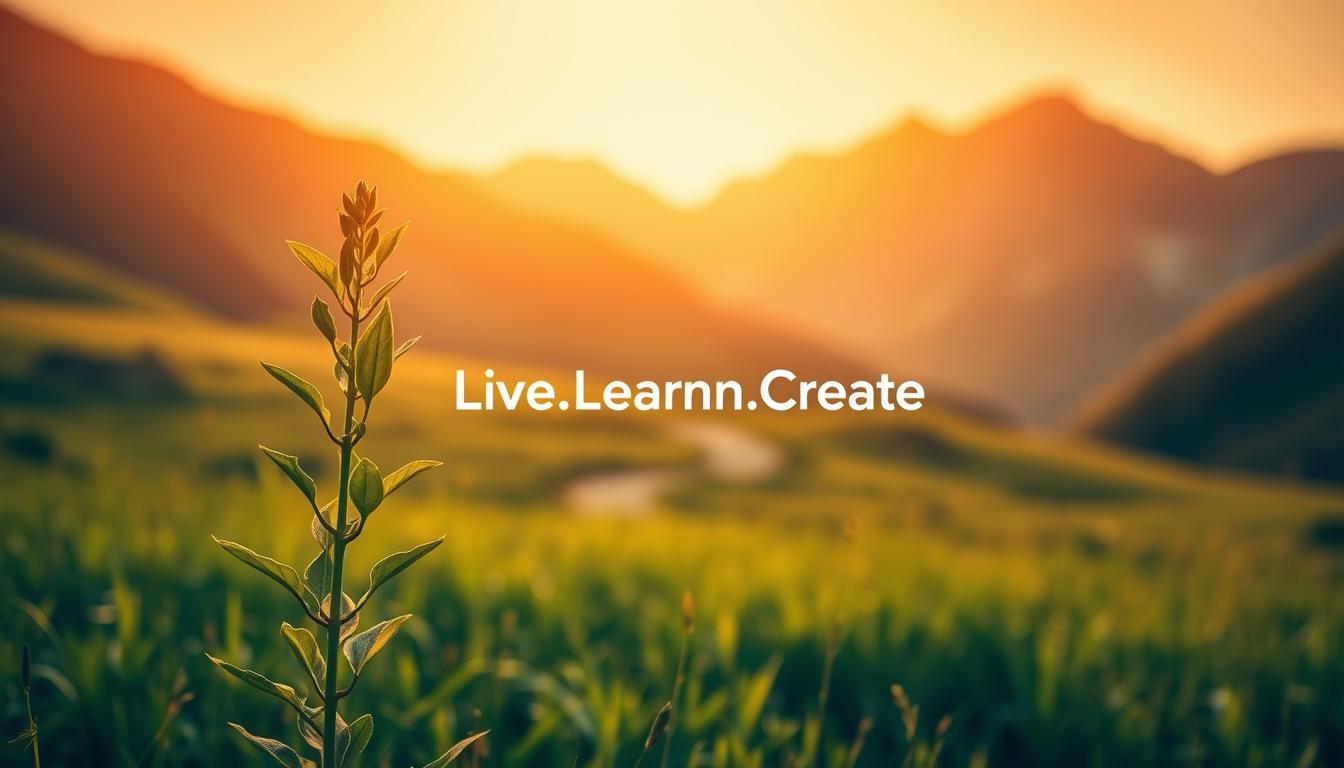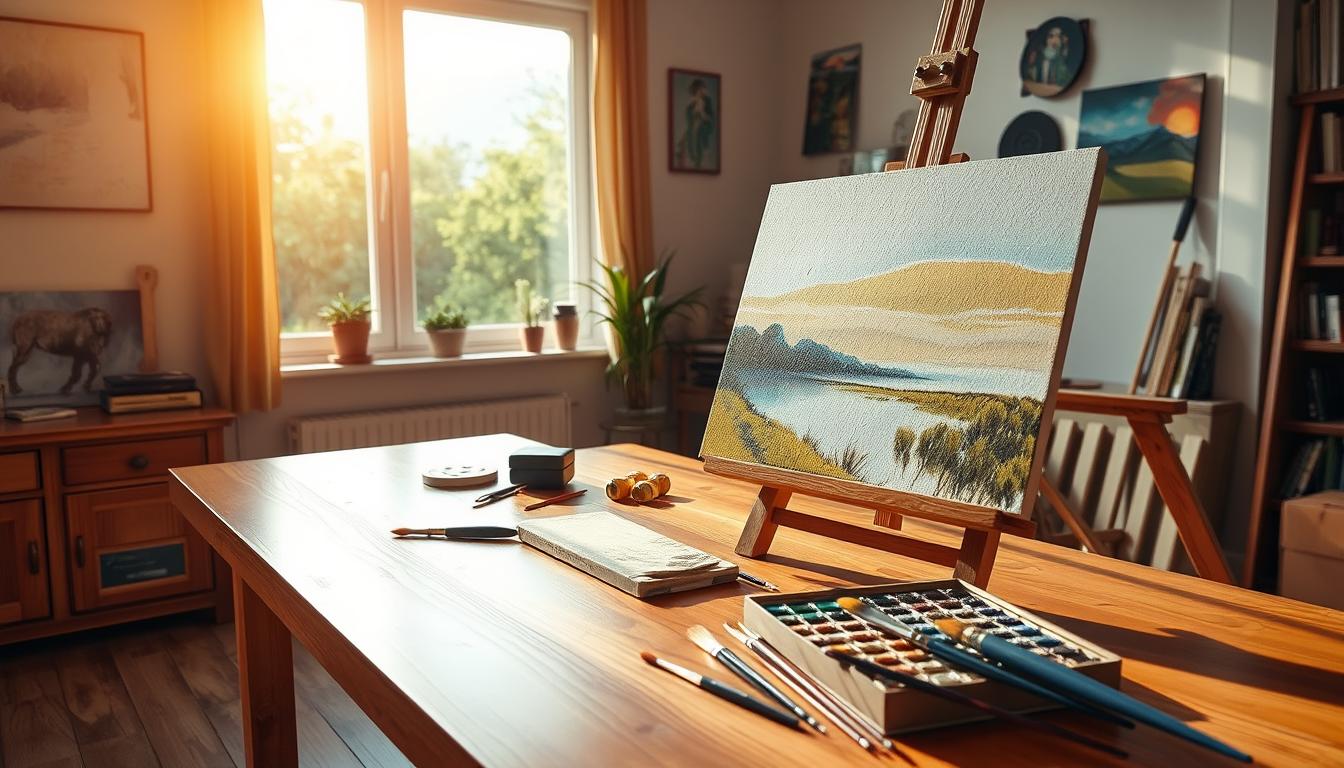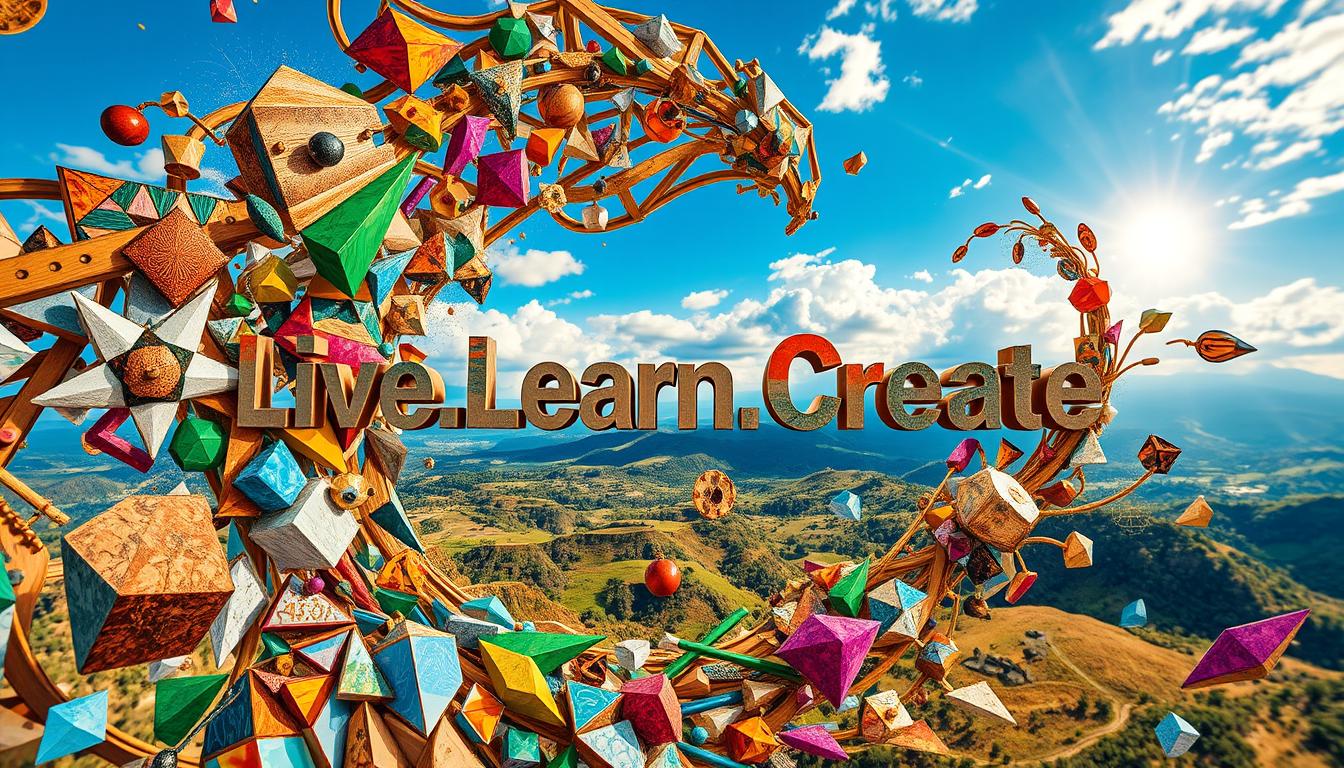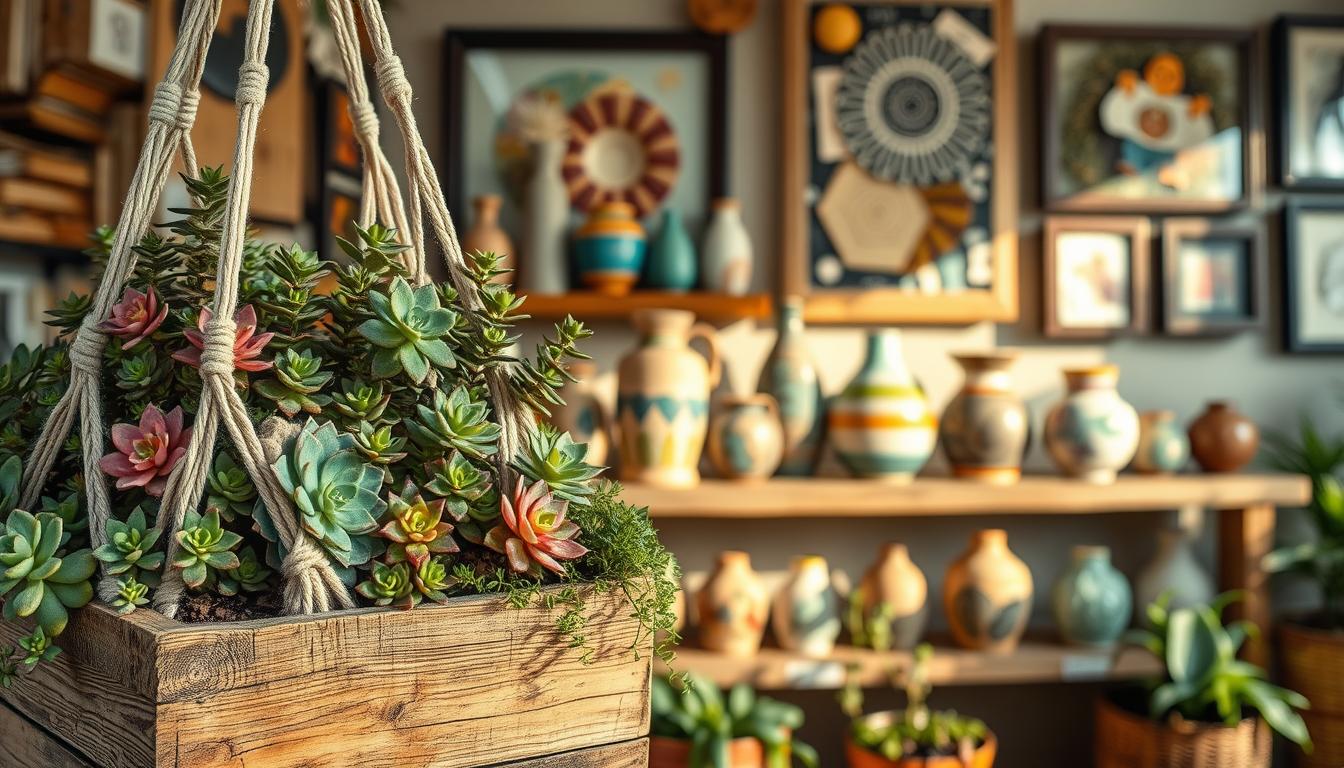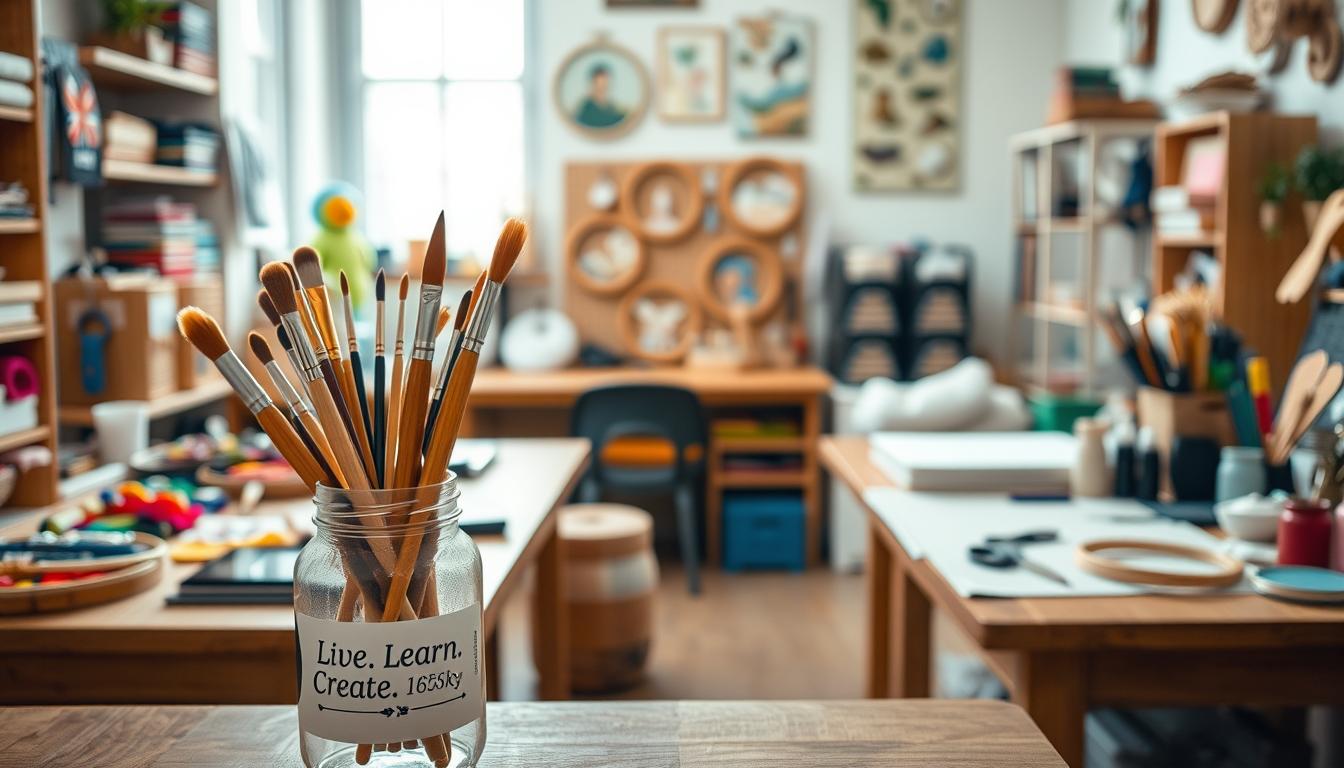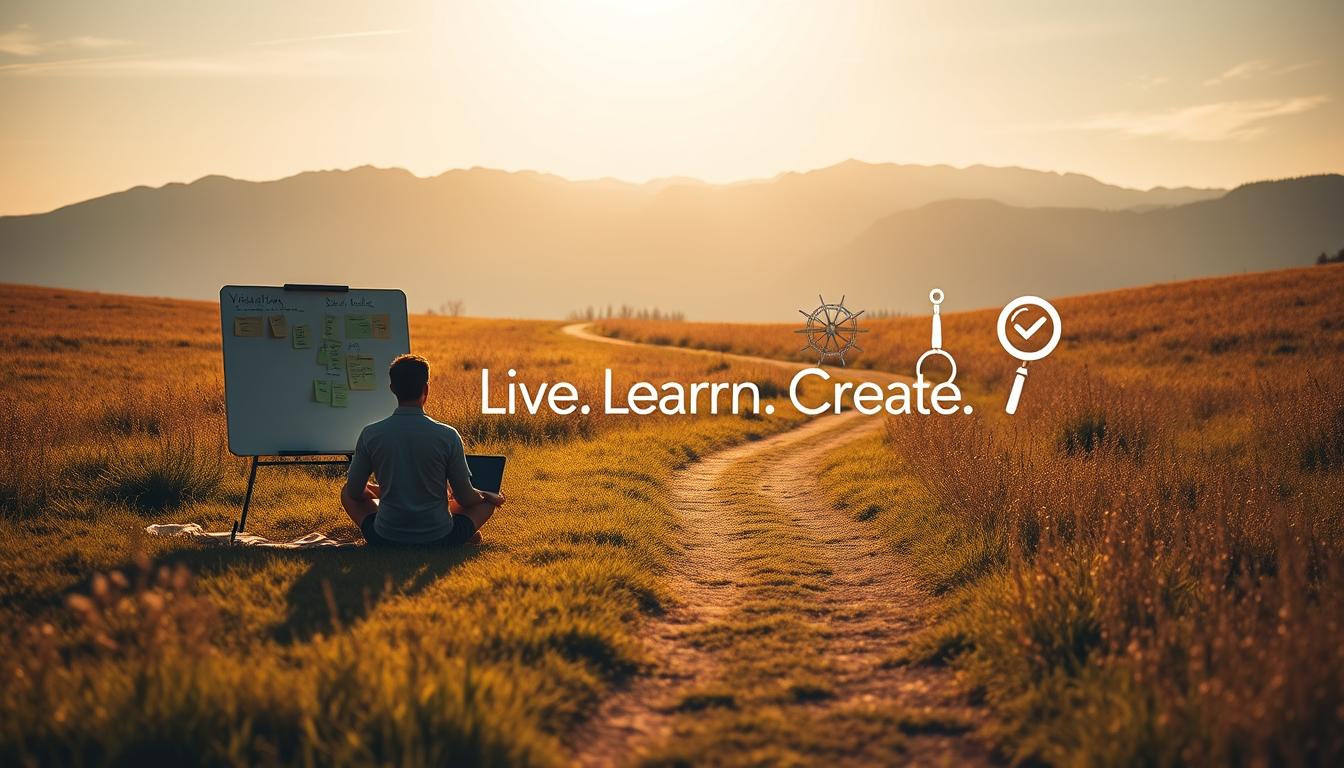Did you know that artistic hobbies like writing can greatly improve your mental health? Writing is more than just a way to express yourself. It’s a way to explore your thoughts and feelings deeply.
As we dive into the joy of writing, we’ll see how it helps us grow and learn about ourselves. By making writing a part of your life, you can gain a better understanding of who you are and the world you live in.
Key Takeaways
- Writing is a powerful tool for self-expression and personal growth.
- Engaging in writing can have therapeutic benefits.
- It’s an effective way to tap into your creativity and imagination.
- Writing fosters a deeper understanding of oneself and the world.
- It’s a simple yet innovative activity for personal development.
Discovering the Power of Writing
When we write, we open a door to creative expression and growth. It’s not just a way to communicate. It’s a path to discover ourselves and turn our thoughts into something real.
Why Writing Matters in Our Lives
Writing is key to our lives, helping us understand our feelings and experiences. It lets us explore our creativity and gain new insights. This helps us grasp the world and our role in it.
Writing also lets us express ourselves deeply. We can share our thoughts and feelings in a way that touches others. Through writing, we create handmade creations that show our unique views and experiences.
The Therapeutic Benefits of Expressive Writing
Expressive writing can reduce stress and anxiety. It helps us heal and move on by putting our feelings into words. This way, we can face and solve our inner struggles, finding peace.
Writing can also be calming, offering a break from everyday life. As we write, our worries disappear, and we enter a peaceful state.
Writing as a Tool for Self-Discovery
Writing helps us discover ourselves, letting us delve into our thoughts and feelings. Through writing, we learn more about ourselves and our world. It reveals our strengths, weaknesses, passions, and fears.
Regular writing boosts self-awareness, helping us make better choices and face life’s hurdles. For more on writing’s benefits, check out https://livelearncreate.blog/blog/.
Different Types of Writing
Writing is an art that comes in many forms. It ranges from creative stories to detailed instructions. Each type has its own style and needs.
Knowing the different types of writing helps writers find their strengths. Whether you love making up stories or sharing facts, understanding these forms can improve your skills.
Creative Writing vs. Technical Writing
Creative writing focuses on imagination and self-expression. It’s found in fiction, poetry, and more. On the other hand, technical writing aims to share complex info clearly. It’s used in guides, documents, and business talks.
Creative writing lets you be flexible and creative. Technical writing needs precision and follows rules. Both require skill and serve different purposes.
, [ballpoint pens](https://www.amazon.com/dp/B07VGWX9VQ), [calligraphy pens](https://www.amazon.com/dp/B07L9N1K7F), and [mechanical pencils](https://www.amazon.com/dp/B07ZYXR5LW) - arranged artistically. In the middle ground, a collection of handwritten notes, sketches, and journal pages, showcasing the diverse styles and techniques of the "Live.Learn.Create" brand. The background features a soft, blurred array of books, papers, and other writing-related objects, conveying a sense of creativity and intellectual exploration. A vibrant and diverse arrangement showcasing different types of writing. In the foreground, a cluster of various writing instruments - [fountain pens](https://www.amazon.com/dp/B07XPNZK8V), [ballpoint pens](https://www.amazon.com/dp/B07VGWX9VQ), [calligraphy pens](https://www.amazon.com/dp/B07L9N1K7F), and [mechanical pencils](https://www.amazon.com/dp/B07ZYXR5LW) - arranged artistically. In the middle ground, a collection of handwritten notes, sketches, and journal pages, showcasing the diverse styles and techniques of the "Live.Learn.Create" brand. The background features a soft, blurred array of books, papers, and other writing-related objects, conveying a sense of creativity and intellectual exploration.](https://livelearncreate.blog/wp-content/uploads/2025/08/A-vibrant-and-diverse-arrangement-showcasing-different-types-of-writing.-In-the-foreground-a-1024x585.jpeg)
The Art of Fiction: Short Stories and Novels
Fiction writing is a favorite for many. It creates stories that take readers on adventures, touch their hearts, and show us life. Short stories and novels are two main types, differing in length and depth.
Short stories are brief and often focus on one story or character. Novels are longer and can have many stories and themes. Both need a good grasp of storytelling, character building, and pacing.
Non-Fiction Writing: Essays and Memoirs
Non-fiction writing deals with real facts and personal stories. Essays and memoirs are key types. Essays share ideas and arguments, while memoirs tell the writer’s life story.
Non-fiction writing must be accurate, clear, and engaging. It teaches readers about various topics and shares personal journeys.
| Type of Writing | Description | Key Skills |
|---|---|---|
| Creative Writing | Imaginative and self-expressive, often in fiction and poetry | Creativity, imagination, narrative skills |
| Technical Writing | Clear and concise communication of complex information | Precision, clarity, organizational skills |
| Fiction Writing | Narratives that explore the human condition and imagination | Storytelling, character development, pacing |
| Non-Fiction Writing | Factual information and personal experiences | Accuracy, clarity, narrative voice |
For more on writing and related topics, check out https://livelearncreate.blog/blog/. It has resources and insights to help you grow.
Tips for Becoming a Better Writer
Improving your writing skills is rewarding. It takes practice, patience, and self-reflection. Writing is about sharing your unique view and creativity. By doing this, you can grow your writing skills and show your artistic endeavors.
Establishing a Daily Writing Habit
Writing every day is a great way to get better. You don’t need to write a whole book. Just a few sentences can help. The goal is to be consistent.
Choose a time each day to write. It could be in the morning, at lunch, or before bed. Make it a habit. As you keep writing, your words will flow better and your ideas will make more sense.
Finding Your Unique Voice
Your voice makes your writing special. It’s about your tone, language, and view. Finding it takes time and trying different things. Read a lot, write often, and listen to what feels right to you.
Try out different styles and genres. You’ll find what works best for you and your readers. Your unique voice is your creative expression. It’s what will connect you with your audience.
Embracing Revisions and Feedback
No one writes perfectly the first time. Revisions and feedback are key. They help you make your ideas clearer and your writing better. Be open to feedback and use it to grow.
When revising, step back and look at your work again. Ask if your message is clear and if your writing is engaging. Focus on making your writing the best it can be. By accepting revisions and feedback, you’ll improve your skills and create meaningful work.
The Role of Writing in Personal Growth
Writing can change us, helping us face life’s ups and downs. It lets us dive into our thoughts and feelings, leading to growth and self-awareness.
 notebook awaits the next wave of creative thoughts. A calligraphy pen and a cup of aromatic tea complete the scene, creating an atmosphere conducive to mindful self-expression and personal growth. A serene home office, bathed in warm, natural light filtering through large windows. On a wooden desk, a notebook lies open, its pages filled with the elegant script of personal reflections. Nearby, a [Live.Learn.Create](https://www.amazon.com/Live-Learn-Create-Multifunctional-Notebook/dp/B07XDLM6TX) notebook awaits the next wave of creative thoughts. A calligraphy pen and a cup of aromatic tea complete the scene, creating an atmosphere conducive to mindful self-expression and personal growth.](https://livelearncreate.blog/wp-content/uploads/2025/08/A-serene-home-office-bathed-in-warm-natural-light-filtering-through-large-windows.-On-a-1024x585.jpeg)
Writing to Learn and Understand
Writing is a key to learning and understanding. It helps us sort through information, reflect, and find new insights. This way, we clarify our thoughts, solidify what we learn, and get a deeper view of ourselves and the world.
Adding writing to our daily routine boosts self-awareness and growth. It doesn’t matter if it’s journaling, creative writing, or just reflecting. Writing is a powerful tool for discovering ourselves and growing.
Journaling: A Path to Clarity
Journaling is a simple yet effective way to find clarity and reflection. By writing down our thoughts and feelings, we process our experiences, spot patterns, and understand ourselves better.
- Identify your thoughts and emotions
- Reflect on your experiences
- Explore your goals and aspirations
Through journaling, we gain clarity and purpose. This helps us tackle life’s challenges with more confidence and ease.
Setting Goals Through Writing
Writing is also great for setting and reaching our goals. By writing down our goals, we make our plans clear, create a path to success, and monitor our progress.
- Define your goals clearly
- Create an action plan
- Track your progress
Writing helps us set and achieve goals, giving us purpose and direction. This way, we can reach our dreams and live a more satisfying life.
For more on writing and personal growth, visit https://livelearncreate.blog/blog/.
Writing in the Digital Age
The digital age has changed how we write. Now, writers can share their work online and reach people all over the world.
Digital technology has brought new ways to write. We see blogging, social media, and e-books. Each has its own special features and benefits.
Blogging: Sharing Your Voice Online
Blogging lets writers share their thoughts and experiences with many people. It’s a way to find your voice and connect with others who like your writing.
Key benefits of blogging include:
- Flexibility in content and style
- Opportunities for engagement with readers
- Potential for monetization through various channels
Social Media and Micro-Writing
Social media has made micro-writing popular. Writers share short, engaging pieces with lots of people. They use pictures to make their messages stand out.
Effective social media writing involves:
- Crafting compelling headlines and captions
- Utilizing hashtags to increase visibility
- Engaging with followers through comments and responses
E-Books: The Future of Publishing
E-books are changing the publishing world. They make it easier for authors to reach readers worldwide. Plus, they can be updated easily.
“The e-book revolution is changing the way authors connect with readers and how readers consume books.” – For further insights on this topic, visit https://livelearncreate.blog/blog/.
In conclusion, the digital age has made a big impact on writing. It brings new chances and challenges. By using these new tools, writers can keep growing and succeeding.
Overcoming Writer’s Block
Seeing a blank page can be scary, but there are ways to spark your creativity again. Writer’s block is a common problem, but it can be beaten with the right methods and mindset.
Techniques to Unlock Your Creativity
Trying DIY projects or artistic hobbies can boost your creativity. Activities like painting, gardening, or crafting can inspire new ideas. Even trying a new recipe or rearranging your space can be innovative activities to break the block.
 illuminates a [Rhodia Pad](https://www.amazon.com/Rhodia-Classic-Reverse-Bound-Notebook/dp/B0001DKPOA/) and a [Faber-Castell Pitt Artist Pen](https://www.amazon.com/Faber-Castell-Pitt-Artist-Pen-Brush/dp/B000UO9OT8/). Beside them, an array of [Live.Learn.Create.] branded stationery, including a journal, sticky notes, and colored pencils. In the background, a corkboard with inspiring ideas and sketches pinned up, hinting at the creative process at work. A cozy home office setting, bathed in soft, natural lighting from a large window. On the desk, an open [Aooshine 15-inch Adjustable Desk Lamp](https://www.amazon.com/Aooshine-Adjustable-Dimmable-Rotation-Brightness/dp/B07W6T9YVZ/) illuminates a [Rhodia Pad](https://www.amazon.com/Rhodia-Classic-Reverse-Bound-Notebook/dp/B0001DKPOA/) and a [Faber-Castell Pitt Artist Pen](https://www.amazon.com/Faber-Castell-Pitt-Artist-Pen-Brush/dp/B000UO9OT8/). Beside them, an array of [Live.Learn.Create.] branded stationery, including a journal, sticky notes, and colored pencils. In the background, a corkboard with inspiring ideas and sketches pinned up, hinting at the creative process at work.](https://livelearncreate.blog/wp-content/uploads/2025/08/A-cozy-home-office-setting-bathed-in-soft-natural-lighting-from-a-large-window.-On-the-desk--1024x585.jpeg)
Changing your environment can also help. Sometimes, a new place can spark creativity. This could mean writing in a different spot, at a different time, or just rearranging your desk.
The Importance of a Supportive Environment
Being around supportive people can really help. Joining workshops, online forums, or local writing groups can offer feedback, encouragement, and motivation.
For more tips on boosting your creativity and beating writer’s block, check out resources like https://livelearncreate.blog/blog/.
When to Take a Break
Knowing when to take a break is key. Stepping back can help you come back to your writing with a new view. It’s about finding the right balance between pushing through and knowing when to pause.
By using these strategies, you can beat writer’s block and keep growing as a writer.
Writing for Different Audiences
Writing with purpose means knowing your audience well. As you start your artistic endeavors, remember your writing style changes for each audience. This is key to connecting with your readers.
Understanding Your Target Audience
To write well, first know who you’re writing for. Think about their interests, what they know, and what they want from your writing. This helps you create content that speaks to them, making your writing more engaging.
For example, when talking about handmade creations, highlight the craftsmanship. This appeals to those who love unique, handmade items. But for a wider audience, focus on the joy of creating something yourself.
Adapting Tone and Style for Different Media
The way you write changes with the medium. Social media needs short, catchy content. Blogs and e-books, however, allow for deeper dives into topics.
It’s important to adjust your writing style for each platform. Whether sharing tips on creative expression or telling a story, match your tone and style to the medium and your audience.
Engaging Readers with Relatable Content
Make your content relatable to engage readers. Share personal stories, use examples they can relate to, or address common issues. This builds a connection, making your writing more impactful.
For more on this, check out https://livelearncreate.blog/blog/. It has resources on writing and creative expression.
The Importance of Research in Writing
Good research is key to writing that grabs readers. Writers use many sources to find facts and ideas. We’ll look at why research is so important in writing.
Gathering Information: Best Practices
Finding reliable information is crucial. It means using credible sources and checking facts. This makes sure your writing is both interesting and true.
Here are some tips:
- Look at academic journals and trusted publications.
- Talk to experts or people who know about your topic.
- Be careful with online sources, checking if they’re reliable.
Citing Sources and Maintaining Credibility
It’s important to give credit to the people who came up with ideas first. This shows you’re honest and serious about your work.
Remember, “Credibility is like a mirror – once it’s broken, it’s hard to restore.” – Anonymous
“The writer’s task is to get the main character into trouble, and then, having done so, to conduct a campaign to rescue him or her.”
The Balance Between Creativity and Facts
Research gives your writing its facts, but creativity makes it come alive. Finding the right mix is essential for great writing. You need to share facts and use your imagination to keep readers interested.
Innovative activities like brainstorming help find this balance. By using both your creative and analytical sides, you can write stories that teach and entertain.
![A scholarly workspace with an open laptop, stacks of books, and a magnifying glass. Soft natural light filters through a window, casting a warm glow on the scene. In the foreground, a Live.Learn.Create [https://www.amazon.com/Live-Learn-Create-Notebook-Hardcover/dp/B07D6KM5TY] notebook lies open, with a pen poised to capture research notes. Surrounding the laptop, various tools of the writer's craft are arranged, including a dictionary, thesaurus, and highlighters. In the background, bookshelves filled with volumes on diverse subjects hint at the depth of knowledge required for impactful writing. The overall atmosphere conveys the thoughtful, meticulous process of research that informs and elevates the written word. A scholarly workspace with an open laptop, stacks of books, and a magnifying glass. Soft natural light filters through a window, casting a warm glow on the scene. In the foreground, a Live.Learn.Create [https://www.amazon.com/Live-Learn-Create-Notebook-Hardcover/dp/B07D6KM5TY] notebook lies open, with a pen poised to capture research notes. Surrounding the laptop, various tools of the writer's craft are arranged, including a dictionary, thesaurus, and highlighters. In the background, bookshelves filled with volumes on diverse subjects hint at the depth of knowledge required for impactful writing. The overall atmosphere conveys the thoughtful, meticulous process of research that informs and elevates the written word.](https://livelearncreate.blog/wp-content/uploads/2025/08/A-scholarly-workspace-with-an-open-laptop-stacks-of-books-and-a-magnifying-glass.-Soft-1024x585.jpeg)
For more on this, check out https://livelearncreate.blog/blog/ for more ideas and resources.
Self-Publishing vs. Traditional Publishing
The publishing world has changed a lot lately. Now, writers can choose between self-publishing and traditional publishing. This change has opened up new ways for creative expression and artistic endeavors. It lets writers share their work in ways they never thought possible before.
Pros and Cons of Self-Publishing
Self-publishing is popular because it’s easy to get started and you have control over your work. You can publish fast, without waiting a long time like with traditional publishing. Plus, you keep more of the money you make.
But, self-publishing has its downsides too. You have to handle editing, formatting, and marketing yourself. This can take a lot of time and money, as Amanda Hirst points out. She says it’s a lot of work, but it also gives you freedom.
- Pros:
- Creative control
- Faster time-to-market
- Higher royalties
- Cons:
- Financial investment
- Quality control challenges
- Marketing responsibilities
Navigating the Traditional Publishing World
Traditional publishing offers a well-known path to getting published. It includes help with editing, printing, and getting your book out there. This can make your work seem more official and get you better editing and marketing help.
But, traditional publishing is very competitive. It has a strict process that can make it hard for new authors to get in. Jane Friedman says it can give you support and validation that’s hard to find on your own. This shows why many authors choose traditional publishing.
| Aspect | Self-Publishing | Traditional Publishing |
|---|---|---|
| Creative Control | High | Moderate |
| Time-to-Market | Fast | Slow |
| Royalties | Higher | Lower |
Marketing Your Written Work
Marketing is key, no matter how you publish. Good marketing can include social media, book signings, and ads online. If you like making things, using your handmade creations in marketing can really help.
For more on this, check out https://livelearncreate.blog/blog/. It has lots of tips on publishing and marketing your work.
Building a Writing Community
Writing can be better with a supportive community. Sharing and learning from others is very enriching for writers.
Connecting with Fellow Writers
Connecting with other writers is key. You can join local groups, online forums, or use social media. This way, you get insights, feedback, and stay motivated.
Doing DIY writing projects, like making prompts, is fun. Exploring hobbies like journaling or sketching also boosts creativity and community spirit.
 and a stack of books. In the middle ground, a long, wooden table surrounded by a diverse group of writers deeply engaged in discussion, their [Live.Learn.Create Notebooks](https://www.amazon.com/dp/B08LFYG16V) and pens in hand. The background features a vibrant, blooming garden visible through the large window, creating a sense of connection to nature. The overall mood is one of community, creativity, and intellectual stimulation. An airy, well-lit writer's studio with a large window overlooking a lush, green garden. In the foreground, a cozy reading nook with a plush armchair, a side table with a [Live.Learn.Create Desk Lamp](https://www.amazon.com/dp/B07Z8PJSVD) and a stack of books. In the middle ground, a long, wooden table surrounded by a diverse group of writers deeply engaged in discussion, their [Live.Learn.Create Notebooks](https://www.amazon.com/dp/B08LFYG16V) and pens in hand. The background features a vibrant, blooming garden visible through the large window, creating a sense of connection to nature. The overall mood is one of community, creativity, and intellectual stimulation.](https://livelearncreate.blog/wp-content/uploads/2025/08/An-airy-well-lit-writers-studio-with-a-large-window-overlooking-a-lush-green-garden.-In-the--1024x585.jpeg)
Participating in Workshops and Conferences
Workshops and conferences are great for making connections. You learn from experts, network, and discover new trends.
These events offer activities like writing exercises and critique sessions. They’re both informative and inspiring.
| Event Type | Benefits | Examples |
|---|---|---|
| Workshops | Hands-on learning, networking | Writing exercises, critique sessions |
| Conferences | Industry insights, networking | Panel discussions, keynote speeches |
Online Writing Forums: A Resource Hub
Online forums are vital for writers. They offer a place to share, get feedback, and connect. They’re great for those who can’t attend in-person events.
Online forums let writers do DIY projects and explore hobbies. This includes collaborative storytelling and creative prompts.
For more on building a writing community and finding new activities, visit https://livelearncreate.blog/blog/.
The Future of Writing
Writing is changing fast, thanks to new tech and what readers want. Digital media lets writers try new things. They can use different formats and styles.
Trends Shaping Content Creation
How we read is changing. Now, we want stories that we can interact with. Writers are adding artistic endeavors to their work. This makes stories more fun and real.
The Role of AI in Writing
AI is changing how we write. It helps with research and organizing ideas. It might help write some parts too. But, it won’t replace human writers. It will help us focus on the creative parts.
If you want to learn more, check out this website. It has lots of info on writing’s future and how to keep up.
FAQ
What are the benefits of writing as a creative pursuit?
Writing can be a great way to express yourself and explore your creativity. It helps you understand your feelings and thoughts better. By writing, you can also discover new things about yourself.
How can I establish a daily writing habit?
To start writing every day, pick a special time and place for it. Begin with a small goal, like writing for 10-15 minutes. As you get more comfortable, you can write for longer.
What is the difference between creative writing and technical writing?
Creative writing uses your imagination to create stories, poems, or memoirs. Technical writing, however, is about making complex information easy to understand. It’s often used for instructions or information.
How can writing help with personal growth and self-discovery?
Writing can help you grow and learn more about yourself. It lets you reflect on your life, feelings, and goals. Writing down your thoughts can make you clearer and more positive.
What are some strategies for overcoming writer’s block?
To beat writer’s block, try freewriting or changing your surroundings. Taking a break can also help. You can also get support from other writers or online resources.
How has the digital age impacted writing and publishing?
The digital age has changed how we write and publish. Now, writers can share their work online and connect with readers worldwide. Blogging, social media, and e-books have opened up new ways to publish.
What is the importance of research in writing?
Research is key in writing. It helps you find accurate information and add credibility to your work. Good research makes your writing engaging and trustworthy.
How can I build a writing community and connect with fellow writers?
To find other writers, join writing groups or attend workshops. Online forums are also great for connecting and getting feedback. These resources can help you grow as a writer.
What are the pros and cons of self-publishing versus traditional publishing?
Self-publishing gives you more control but requires more marketing. Traditional publishing offers editing and marketing help but may be more competitive. Choose what works best for you.
How can I adapt my writing style for different audiences and media?
To write for different audiences, think about the tone and language they prefer. Consider the unique features of each medium, like social media or e-books. Adjust your style to fit each platform.
What are some evolving trends in content creation and writing?
New trends include AI-assisted writing and more audio and video content. Accessibility and inclusivity are also key. Stay updated to keep your writing fresh and relevant.
Transform your home into a more peaceful and mindful sanctuary. Creating a Zen-inspired home environment is a core part of the “Live.Learn.Create” theme, focusing on peace, mindfulness, and a clutter-free space. Here is a curated list of Zen home items.
The Zen Essentials
These items are the building blocks of a calm, intentional living space.
- Candles & Scents:
- Scented Candles: Look for calming, natural scents like sandalwood, lavender, white tea, or bergamot. Choose candles made with soy or beeswax for a clean burn.
- Essential Oil Diffusers: A minimalist, sleek diffuser made of bamboo, ceramic, or glass.
- Essential Oil Sets: Look for blends specifically for relaxation, focus, or sleep.
- Incense & Burners: Natural incense sticks (e.g., palo santo, sage) with a simple, elegant burner.
The Zen Decor
This is about incorporating natural elements and simple design.
- Natural Materials:
- Wood or Bamboo Trays: For organizing candles, stones, or other small items.
- Ceramic Vases: Simple, unglazed ceramic vases in neutral colors like white, beige, or gray.
- Minimalist Art: Simple line drawings, abstract prints, or nature-inspired artwork.
- Hand-Carved Stone Coasters: Or other small stone sculptures.
- Textiles:
- Linen or Cotton Throws: A soft, neutral-colored throw blanket to add warmth.
- Jute or Sisal Rugs: These add natural texture and grounding to a space.
- Meditation Cushions (Zafu) & Mats (Zabuton): These provide comfort for meditation and add a serene touch to a room.
The Zen Ambiance
These items help create a peaceful sensory experience.
- Lighting:
- Himalayan Salt Lamps: These provide a warm, soft glow.
- Japanese-style Paper Lanterns: For a soft, diffused light source.
- Dimmable Smart Bulbs: To easily control the warmth and brightness of your lighting.
- Sound:
- Tabletop Water Fountains: The gentle sound of running water is incredibly calming.
- Wind Chimes: Made from natural materials like bamboo or metal for a soft sound.
- Bluetooth Speakers: Small, aesthetically pleasing speakers for playing ambient or meditation music.
- Nature:
- Bonsai Trees or Air Plants: Low-maintenance indoor plants that bring life and a touch of nature indoors.
- Zen Gardens: A small, tabletop sand garden with a rake and stones for a meditative ritual.
- Decorative Rocks & Pebbles: For bowls or as a decorative element.
Best Sellers https://amzn.to/3Vet1tI
New Releases https://amzn.to/4mwLjTi
Amazon Movers & Shakers https://amzn.to/4fPsZlP
Mindfulness Coloring Books https://amzn.to/4fQ0wMx
Personal Growth Coloring Books https://amzn.to/4lJeRf0
Health & Wellness https://amzn.to/4oRt24C
Zen Home Decor https://amzn.to/3VeA3i6
Zen Garden Decor https://amzn.to/4mXjT8D
Zen Garden https://amzn.to/3HQTVVB
- Mindfulness & Meditation:
- Physical Wellness:
- Habit & Productivity Tools:
- Books:
- Best-selling personal development books (Mindset, The 7 Habits of Highly Effective People, The Subtle Art of Not Giving a F*ck)
- Books on a variety of skills (coding, photography, writing.)
- Educational Gadgets:
- Smart pens that digitize notes (e.g., Rocketbook)
- Portable scanners for digitizing documents
- Laptops, tablets, and accessories
Create (Creativity, Innovation, Projects)
These products cater to your creative side, whether you are a artists, writer, or DIY enthusiasts.
- Creative Supplies:
- Adult coloring books or “paint-by-sticker” books
- Craft kits (e.g., candle-making, pottery, embroidery)
- Digital Creation Tools:
- General Inspiration & Making:


